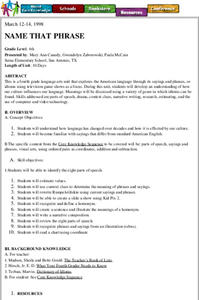Curated OER
"how To Think Like an Archaeologist" Suggested Pre-visit Activity for Historic Jamestowne
Young scholars study grocery receipts to simulate the archaeological activity of classifying items. They discuss the receipts as if they were find lists.
Curated OER
Angle Measurement of Aircraft Wings and Tails
Students measure the angles of wings and tails of various aircraft using a protractor. They estimate and check their measurements. They investigate aircraft being developed and tested at NASA Dryden.
Curated OER
Buying My First Car
Students pretend they are about to buy their first new car. They must do all the calculations necessary to estimate the cost of purchasing the car. They see that the math they learn in school really does have real-life applications.
Curated OER
Angles: Angles, Angles, Everywhere
Pupils estimate and accurately measure the size of angles communicate with the appropriate geometric terms and symbols to describe and name angles, lines, line segments, rays
Curated OER
Calculating the Shortest Distance Between Two Points
Ninth graders calculate the distance between two points.
Curated OER
"How to Think Like an Archaeologist" - Suggested Pre-Visit Activity For Historic Jamestown
Young scholars examine how archaeologists use artifacts to explore other people and their cultures. They discuss types of artifacts, analyze receipts for clues, and discuss how what the items bought reflect about people.
Curated OER
How To Think Like An Archaeologist
Students take a field trip to historical Jamestown. Using artifacts given to them, they must identify them and discover who would have used them and for what purpose. They create a database to organize the information and share it with...
Curated OER
Escape The Hangman
Seventh graders investigate the concept of probability. They use the game of hangman to create engagement and context for conducting the lesson. They create a spreadsheet with data that is given. Students make predictions based on data.
Curated OER
Inventors Timelines
Students create a class timeline using the patent year for their selected inventor or invention. Using a piece of yarn, they physically create a timeline, and create and answer math word problems using the years from the timeline.
Curated OER
Name That Phrase
Students identify the American language, how it has changed and effected culture, and become familiar with idioms. In this American language lesson, students study the eight parts of speech, identify literal and figurative speech, study...
Alabama Learning Exchange
The Composition of Seawater
Students explore the concept of finding the composition of seawater. In this finding the composition of seawater instructional activity, students make a saturated salt water solution. Students discuss why there is variation...
Curated OER
Pea Brain! Explorations in Estimation
Students estimate how many peas fit in a container. In this science lesson plan, students calculate the weight of a pea and record it. They use this data to calculate how many peas fit in a human brain.
Curated OER
Triangle Explorer
Students compute the area of triangles in a computer program. In this measurement lesson plan, students complete 5 easy, 5 medium, and 5 hard problems.
ABCya
Ab Cya: Estimating
Soccer Math: Estimating is a fun way for kids to practice estimating sums, differences, products and quotients. There are different levels of difficulty in each exercise making the game appropriate for a variety of students and grades....
AAA Math
Aaa Math: Estimating a Difference
Students can practice estimating differences in a series of self-check exercises and timed learning games.
CK-12 Foundation
Ck 12: Arithmetic: Decimal Rounding to Estimate Sums and Differences
[Free Registration/Login may be required to access all resource tools.] Estimate sums and differences by rounding decimals to whole numbers.
CK-12 Foundation
Ck 12: Elem Math: Rounding the Same Decimal to Different Decimal Places
[Free Registration/Login may be required to access all resource tools.] A video and practice questions where students are presented with a decimal number and must round it to three different decimal place value positions. [2:14]
Illustrative Mathematics
Illustrative Mathematics: 3.nbt Rounding to 50 or 500
Students explore different rounding scenarios. Aligns with CCSS.Math.Content.3.NBT.A.1 Use place value understanding to round whole numbers to the nearest 10 or 100.
ABCya
Ab Cya: Rounding Numbers
Soccer Math: Rounding provides a fun way for kids to practice rounding numbers. There are three different levels of difficulty: 1.Tens & Hundreds 2.Tens, Hundreds & Thousands 3.Tens, Hundreds, Thousands & Decimals Get five...
Texas Instruments
Texas Instruments: Estimating With Rational Numbers
In this activity, students will round fractions and mixed numbers, and then use their rounding skills to estimate sums, differences, products, and quotients.
McGraw Hill
Glencoe: Self Check Quizzes 1 Estimating Fraction Sums and Differences
Use Glencoe's randomly generated self-checking quiz to test your knowledge of estimating sums and differences. Each question has a "Hint" link to help. Choose the correct answer for each problem. At the bottom of the page click the...
AAA Math
Aaa Math: Estimation
Improve your estimation and rounding skills with these interactive games that are challenging and fun. Excellent skills practice for rounding, estimating sums and differences, and front-end estimation. Links to lesson plans, teacher...
ClassFlow
Class Flow: Estimating Sums and Differences
[Free Registration/Login Required] This flipchart is designed to teach third grade students the steps in estimating sums and differences. It also reviews rounding numbers to the nearest ten and hundred.
AAA Math
Aaa Math: Estimating a Difference
This lesson explains how to estimate differences between whole numbers. Gives practice and games to practice this skill in a helpful and fun way.
























